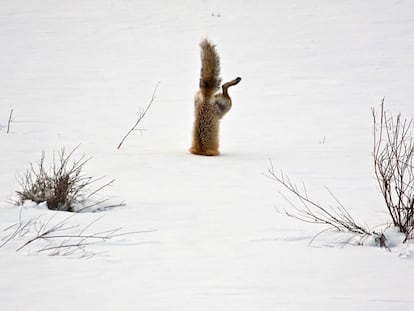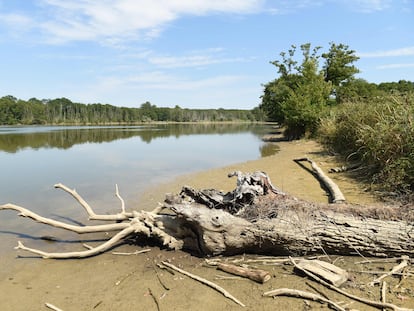Climate change is disrupting hibernation: Female arctic squirrels are shortening it, but the males are not
The warmer winters of recent decades are altering a sophisticated survival strategy shaped by millions of years of evolution

When the cold comes, arctic ground squirrels burrow deep into the ground, until they reach the frozen layer of the earth known as permafrost. There, they sleep through the winter, reducing their metabolic activity to 1% and lowering their temperature to an almost freezing point, one of the most extreme hibernation strategies known to science. In the spring, when the snow begins to recede, they come out of their torpor and once again become the keystone of the arctic terrestrial ecosystem, being preyed upon by foxes, lynxes, wolves, bears and eagles in regions where food is not abundant.
For almost three decades, a group of scientists has studied two populations of these rodents. The results of their work, published in the journal Science, show that 25 years have been enough for climate change to disrupt one of the most sophisticated survival strategies, shaped by millions of years of evolution: female ground squirrels are coming out of hibernation earlier. The males, however, are not. The consequences of this discrepancy remain to be seen.
For different reasons, such as the thermal amplification caused by melting ice or the extended hours of sunshine, global warming is more evident in arctic areas. This is why scientists use the Arctic, and the species that live in it, as sentinels of climate change. One of them is the arctic ground squirrel (Urocitellus parryii), a small animal measuring 15 inches and weighing less than 2 pounds that abounds throughout the arctic strip, from Alaska to Siberia, passing through the north of Canada. For almost 30 years, American researchers in Alaska have followed the life cycle of 199 of these little animals to which they attached sensors, studying the connection between their behavior and local climate change.
“Our data shows that the active layer, the layer of soil above the permafrost, freezes increasingly later in the fall, doesn’t get as cold at the height of winter, and thaws a bit earlier in the spring,” says the US Forest Service scientist Helen Chmura, lead author of the study. The average annual temperature in the study region has risen, especially in winter, since it began in 1993, and the freezing of the soil, which they measured at a depth of one meter (3.3 feet), has been falling behind at a rate of four days per decade. Meanwhile, the minimum soil temperature, which could drop below -30 degrees Celsius (-22 degrees Fahrenheit), has risen by almost 5 degrees Celsius (41 degrees Fahrenheit). Furthermore, Chmura adds, “these changes, which equate to a reduction of about 10 days in the time the ground freezes, have occurred in just 25 years, which is a very fast pace.”
How have hibernating animals reacted to such environmental change? The sensors attached to the ground squirrels show that they have not delayed the onset of torpor, but they are awakening ten days earlier, the same length of time that the freezing of the topsoil has decreased. These rodents are among the few hibernators that use thermogenic torpor. Species from temperate zones, such as bears, are capable of lowering their body temperature to match the ambient temperature of their den. However, in the case of the arctic ground squirrels, the cold can be many degrees below the freezing point, which would freeze their tissues. In order to survive, this animal is capable of reactivating its metabolism enough to generate heat and avoid freezing as many times as necessary. According to this study, they now activate this survival mechanism 37 days less than 25 years ago.
Cory Williams, a biologist at Colorado State University, has studied ground squirrels for two decades, since he worked at the University of Alaska Fairbanks. Williams, a senior author of this study, explains that the key to this matter goes beyond the temperature: “Although this change is caused by climate warming, we don’t believe that temperature is the only signal, or even the most important signal, used by these animals. As part of our long-term study, we found that as the end of hibernation approaches, the females test the conditions on the surface. If there is a heavy layer of snow, they will go back into hibernation, lengthening it.” They only come out of it when there is enough space without snow on the surface to be able to feed, and the greening in these latitudes is occurring increasingly earlier.
What is most striking about this study is that, although males and females start hibernation at the same time, only females have shortened it. Williams explains that both genders wake up at different times: “Males end hibernation more than a month before females. They remain underground for about another month after ending hibernation, feeding on their food reserves; they do so because it takes several weeks for them to go through puberty and reach sexual maturity every spring. By ending hibernation a month before the females, they can ensure that they are physiologically capable of mating as soon as they emerge.”
This difference explains why the advancement of the end of hibernation in females is not such a dramatic matter – for now. In fact, the researchers think that at the moment it is positive, as they have to resort less to thermogenic torpor, a very expensive strategy. However, if the phenomenon continues, a disparity between males and females could occur. Williams believes that, if the trend continues, there will be a strong selection for the early termination of hibernation by the males; he trusts in the plasticity of these animals to respond to the climatic challenge.
Most of the animals that hibernate do so in latitudes where it can get very cold, but not as cold as what that the arctic ground squirrels endure. Temperate regions have no permafrost, so they don’t need a mechanism as extreme as thermogenic torpor. However, climate change is also affecting them. A review published last year with studies on more than thirty species that hibernate showed that the impact of warming is uneven. Except for bats, for which no changes have been detected, most rodents are shortening it. Meanwhile, some species of bears, like the American black bear or the Eurasian brown bear, are delaying the onset of their fall torpor.
Thomas Ruf, a researcher at the Research Institute for Wildlife Ecology of the University of Veterinary Medicine in Vienna, believes that climate change will have a mixed impact with winners and losers: “Different species will be affected differently, depending on their sensitivity to temperature. I think bears will be the least affected, because they are exceptional at maintaining a body temperature above 30 degrees Celsius [86 degrees Fahrenheit] and don’t have periodic awakenings.”
The bears have shortened their torpor
However, the bears are also shortening their hibernation time. The study of 70 years of data collected in 12 national and nature parks in the Soviet Union, later Russia, published in 2018, shows how changes in environmental conditions are affecting brown bears in general. “They are delaying their entry into their den and exiting earlier, thus spending less time hibernating,” says the Spanish biologist María del Mar Delgado, first author of this study.
Delgado works at the Joint Institute for Biodiversity Research of the Spanish National Research Council, the University of Oviedo and the Principality of Asturias. One of her fields of study is the 370 brown bears of the Cantabrian mountain range, in Spain. The weather there is not as cold as in Russia, so “bears don’t hibernate, although they do spend months in a state of torpor,” she points out. “Especially the females, which continue to enter the dens where they finish their pregnancy, give birth and breed until they come out in spring,” she adds. But while they do not hibernate, their problems are the same. “By advancing the moment when they emerge, they suffer greater energy stress; the females have less time to raise their cubs, and the fact that it is hotter does not guarantee that there will be food,” she adds. The imbalance means that, both in Russia and in Spain, “they have to resort to agriculture and livestock, increasing conflicts with humans,” Delgado concludes.
You can follow MATERIA on Facebook,< i> Twitter and Instagram, or sign up here to receive our weekly newsletter.
Tu suscripción se está usando en otro dispositivo
¿Quieres añadir otro usuario a tu suscripción?
Si continúas leyendo en este dispositivo, no se podrá leer en el otro.
FlechaTu suscripción se está usando en otro dispositivo y solo puedes acceder a EL PAÍS desde un dispositivo a la vez.
Si quieres compartir tu cuenta, cambia tu suscripción a la modalidad Premium, así podrás añadir otro usuario. Cada uno accederá con su propia cuenta de email, lo que os permitirá personalizar vuestra experiencia en EL PAÍS.
¿Tienes una suscripción de empresa? Accede aquí para contratar más cuentas.
En el caso de no saber quién está usando tu cuenta, te recomendamos cambiar tu contraseña aquí.
Si decides continuar compartiendo tu cuenta, este mensaje se mostrará en tu dispositivo y en el de la otra persona que está usando tu cuenta de forma indefinida, afectando a tu experiencia de lectura. Puedes consultar aquí los términos y condiciones de la suscripción digital.
More information
Archived In
Últimas noticias
Tiger Woods turns 50: Will he continue playing on the PGA Tour or take a back seat?
The surreal journey of James Nnaji, the Barcelona youth player selected in the NBA Draft who ended up in the NCAA
Trump claims peace in Ukraine is near, but Moscow suggests otherwise
A survivor’s account of the Interoceanic Train accident: ‘We were scared because of the speed on the curve’
Most viewed
- Oona Chaplin: ‘I told James Cameron that I was living in a treehouse and starting a permaculture project with a friend’
- Reinhard Genzel, Nobel laureate in physics: ‘One-minute videos will never give you the truth’
- Why the price of coffee has skyrocketed: from Brazilian plantations to specialty coffee houses
- Pablo Escobar’s hippos: A serious environmental problem, 40 years on
- Chevy Chase, the beloved comedian who was a monster off camera: ‘Not everyone hated him, just the people who’ve worked with him’











































